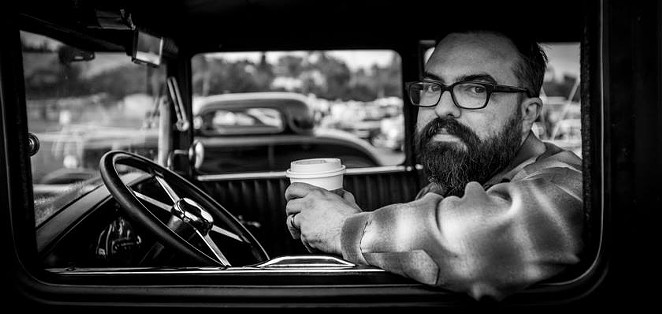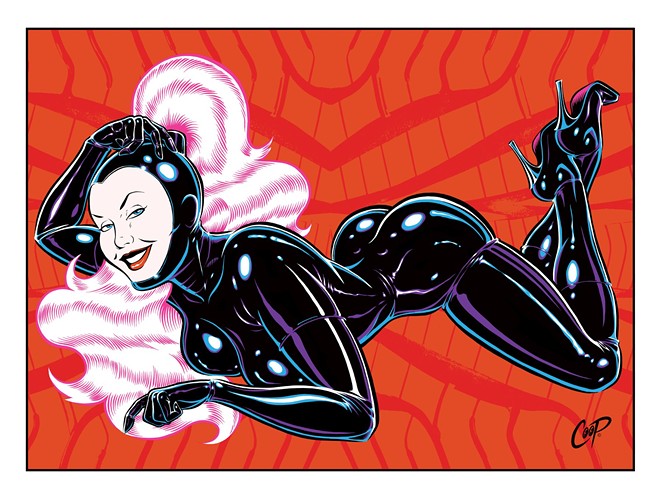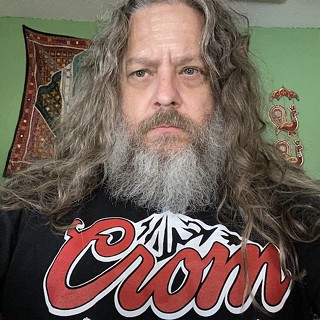Getting Lowbrow with Coop: The Artist Who Fueled the ’90s Rock Poster Boom Headed to San Antonio Library’s Pop Con
By Sanford Nowlin on Wed, Feb 26, 2020 at 3:33 pm
The artist known as Coop — real name: Chris Cooper — burst onto the scene in the ’90s via rock posters that stirred girly art, retro kitsch and dark humor into a colorful cocktail.
Acts ranging from Soundgarden and Nirvana to the Rev. Horton Heat and Lords of Acid made use of his instantly recognizable imagery, including a trademark cigar-chomping devil. From that base, he launched a fine-art career that includes painting, printmaking, and more recently, pin-up photography.
His work has been collected in books including 2001’s Devil’s Advocate: The Art of Coop and 2004’s The Big Fat One. Idle Hands, published in 2012 by Baby Tattoo Books, focuses on his fine art from 2001 to 2012.
Coop, who recently relocated from Los Angeles to Austin, will make an appearance Saturday, February 29, at the San Antonio Public Library’s Pop Con event. We caught up with him by phone to see where his career is taking him these days, besides SA’s downtown library.
Early in your career, you were labeled a “lowbrow artist.” With respectable galleries showing retrospectives of hot rod art and graphic novels winning the Pulitzer and National Book Awards, does that distinction still exist?
A guy named Greg Escalante who’s done a huge amount for the art scene in Southern California came up with the term. He was one of the people involved in creating Juxtapoz Magazine and cast a huge shadow over the scene. I’m pretty indifferent to the term at this point. I mean, it makes sense, but it’s also one of those things where I don’t think any of the artists it’s been used to describe necessarily would have come up with it. On the other hand, I haven’t heard anybody come up something better. I’ve heard things like “pop surrealism,” which sort of fits, but it is what it is. You usually don’t get to pick what you’re known for, and you usually don’t get pick the term your work is known by. I think everybody’s just sort of made peace with it.
Your early visibility came through the underground rock world, which seems to have moved away from that kind of visual aesthetic. Is there still enough work there to sustain a career?
I still do stuff for my friends. Most of those bands I was doing work for in the ’90s were also people I was friends with. They were part of my social circle, although some of them became huge acts later on. When you see posters for bands now, the style is very different. I think part of it is there’s broader variations in style. There’s more room for different illustrative styles and photographic styles. I never really stopped doing stuff for bands, but I don’t get nearly as much work from the record industry, which has a lot to do with the fact that it stopped paying people to do work. It’s part of a larger problem in the music industry, the way streaming has overtaken sales of records and CDs. Of course, artists and photographers are just another group of people waiting in line to make money from an industry that’s not paying anymore. So, that’s kind of why I don’t do it as much.
How did you adapt to that change?
Part of what’s been happening with me, with my own work, over the last 10 years is I’ve been moving away from having to rely on commercial work — as far as illustration work or whatever. The money isn’t there, and it isn’t reliable. I’ve moved into a mode where I’m publishing my own posters, and I’m working on another book that I’m going to self-publish. I decided at a certain point that I was the most reliable person that I was in business with, so I should be giving all my business to myself. It’s taken a while to kind of rebuild in that way, but I’m really happy with where I’m at right now.
Was your move from Southern California part of that decision?
Well, it’s related to it, I should probably say. A lot of it for me is that LA has changed so much in the 30 years I’d been there that it just started to feel like a completely different place, and of course, it was getting more and more expensive every day. For the last four or five years, I’d been talking to my wife and saying, “You know, Austin’s really nice, and it’s a lot cheaper than LA.” I’d come out here once or twice a year — I’d come out for the Lonestar Roundup [hotrod event] — and at one point, my wife realized the firm she worked for had an office in Austin, which meant she could transfer from LA. Once we realized we could do that, there was nothing stopping us. It’s made things a lot easier. Even before I moved, I was using a silkscreen printer based in Austin, so it was incredibly painless for me. The hardest thing was physically moving, you know, moving flat files and six-foot paintings and crazy stuff like that.
I’m sure the reduced expenses made that worthwhile.
I have more money now to pursue the projects I want to pursue. Like, I’m going to be doing a new book of art, and I’m also going to be doing a book of photography. I’m not sure which one is going to come out first, but I’m working on them both. Now, I have an assistant full time, which I could never afford in Los Angeles. It’s been a good deal.
In terms of photography, the pin-up stuff, seems to be a comparatively new thing for you. How’d that come about?
My dad was a photographer, and when I was a kid, he taught me the basics. But I never really did anything with it for a long time. Then, about 2007, I was in an auto accident and I broke my leg, so for about three months I wasn’t able to paint, because at that point I was working on these big canvases and had to stand up. I had been getting more and more interested in photography, so I bought a camera and started shooting again. I really fell in love with it. I think when I was young, when I was a teenager, I didn’t really have the patience to be a photographer. Whereas, as an adult that kind of comes to you easier. The photography has actually changed how I paint and how I approach my illustrating and painting work. The two things have fed each other in a really good way.
Get our top picks for the best events in San Antonio every Thursday morning. Sign up for our Events Newsletter.
Acts ranging from Soundgarden and Nirvana to the Rev. Horton Heat and Lords of Acid made use of his instantly recognizable imagery, including a trademark cigar-chomping devil. From that base, he launched a fine-art career that includes painting, printmaking, and more recently, pin-up photography.
His work has been collected in books including 2001’s Devil’s Advocate: The Art of Coop and 2004’s The Big Fat One. Idle Hands, published in 2012 by Baby Tattoo Books, focuses on his fine art from 2001 to 2012.
Coop, who recently relocated from Los Angeles to Austin, will make an appearance Saturday, February 29, at the San Antonio Public Library’s Pop Con event. We caught up with him by phone to see where his career is taking him these days, besides SA’s downtown library.
Early in your career, you were labeled a “lowbrow artist.” With respectable galleries showing retrospectives of hot rod art and graphic novels winning the Pulitzer and National Book Awards, does that distinction still exist?
A guy named Greg Escalante who’s done a huge amount for the art scene in Southern California came up with the term. He was one of the people involved in creating Juxtapoz Magazine and cast a huge shadow over the scene. I’m pretty indifferent to the term at this point. I mean, it makes sense, but it’s also one of those things where I don’t think any of the artists it’s been used to describe necessarily would have come up with it. On the other hand, I haven’t heard anybody come up something better. I’ve heard things like “pop surrealism,” which sort of fits, but it is what it is. You usually don’t get to pick what you’re known for, and you usually don’t get pick the term your work is known by. I think everybody’s just sort of made peace with it.
Your early visibility came through the underground rock world, which seems to have moved away from that kind of visual aesthetic. Is there still enough work there to sustain a career?
I still do stuff for my friends. Most of those bands I was doing work for in the ’90s were also people I was friends with. They were part of my social circle, although some of them became huge acts later on. When you see posters for bands now, the style is very different. I think part of it is there’s broader variations in style. There’s more room for different illustrative styles and photographic styles. I never really stopped doing stuff for bands, but I don’t get nearly as much work from the record industry, which has a lot to do with the fact that it stopped paying people to do work. It’s part of a larger problem in the music industry, the way streaming has overtaken sales of records and CDs. Of course, artists and photographers are just another group of people waiting in line to make money from an industry that’s not paying anymore. So, that’s kind of why I don’t do it as much.
How did you adapt to that change?
Part of what’s been happening with me, with my own work, over the last 10 years is I’ve been moving away from having to rely on commercial work — as far as illustration work or whatever. The money isn’t there, and it isn’t reliable. I’ve moved into a mode where I’m publishing my own posters, and I’m working on another book that I’m going to self-publish. I decided at a certain point that I was the most reliable person that I was in business with, so I should be giving all my business to myself. It’s taken a while to kind of rebuild in that way, but I’m really happy with where I’m at right now.
Was your move from Southern California part of that decision?
Well, it’s related to it, I should probably say. A lot of it for me is that LA has changed so much in the 30 years I’d been there that it just started to feel like a completely different place, and of course, it was getting more and more expensive every day. For the last four or five years, I’d been talking to my wife and saying, “You know, Austin’s really nice, and it’s a lot cheaper than LA.” I’d come out here once or twice a year — I’d come out for the Lonestar Roundup [hotrod event] — and at one point, my wife realized the firm she worked for had an office in Austin, which meant she could transfer from LA. Once we realized we could do that, there was nothing stopping us. It’s made things a lot easier. Even before I moved, I was using a silkscreen printer based in Austin, so it was incredibly painless for me. The hardest thing was physically moving, you know, moving flat files and six-foot paintings and crazy stuff like that.
I’m sure the reduced expenses made that worthwhile.
I have more money now to pursue the projects I want to pursue. Like, I’m going to be doing a new book of art, and I’m also going to be doing a book of photography. I’m not sure which one is going to come out first, but I’m working on them both. Now, I have an assistant full time, which I could never afford in Los Angeles. It’s been a good deal.
In terms of photography, the pin-up stuff, seems to be a comparatively new thing for you. How’d that come about?
My dad was a photographer, and when I was a kid, he taught me the basics. But I never really did anything with it for a long time. Then, about 2007, I was in an auto accident and I broke my leg, so for about three months I wasn’t able to paint, because at that point I was working on these big canvases and had to stand up. I had been getting more and more interested in photography, so I bought a camera and started shooting again. I really fell in love with it. I think when I was young, when I was a teenager, I didn’t really have the patience to be a photographer. Whereas, as an adult that kind of comes to you easier. The photography has actually changed how I paint and how I approach my illustrating and painting work. The two things have fed each other in a really good way.
Get our top picks for the best events in San Antonio every Thursday morning. Sign up for our Events Newsletter.

KEEP SA CURRENT!
Since 1986, the SA Current has served as the free, independent voice of San Antonio, and we want to keep it that way.
Becoming an SA Current Supporter for as little as $5 a month allows us to continue offering readers access to our coverage of local news, food, nightlife, events, and culture with no paywalls.
Scroll to read more Arts Stories & Interviews articles
About The Author
Newsletters
Join SA Current Newsletters
Subscribe now to get the latest news delivered right to your inbox.
















